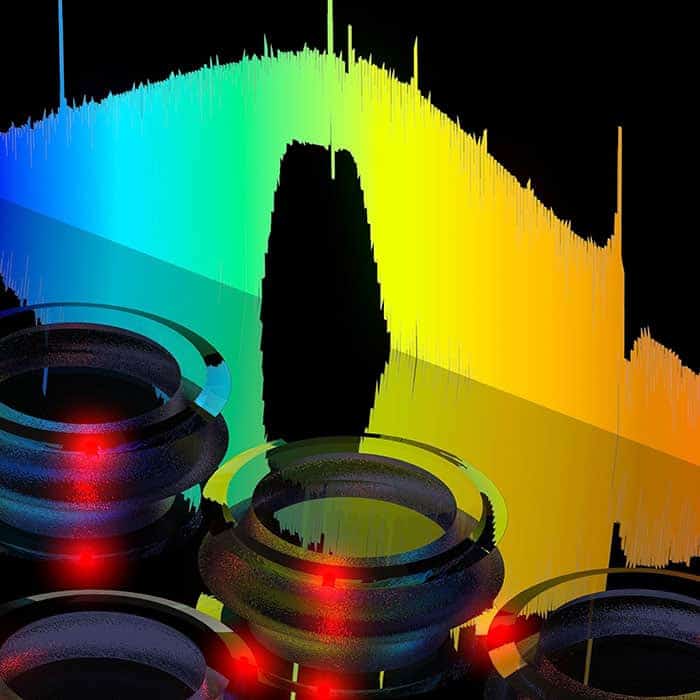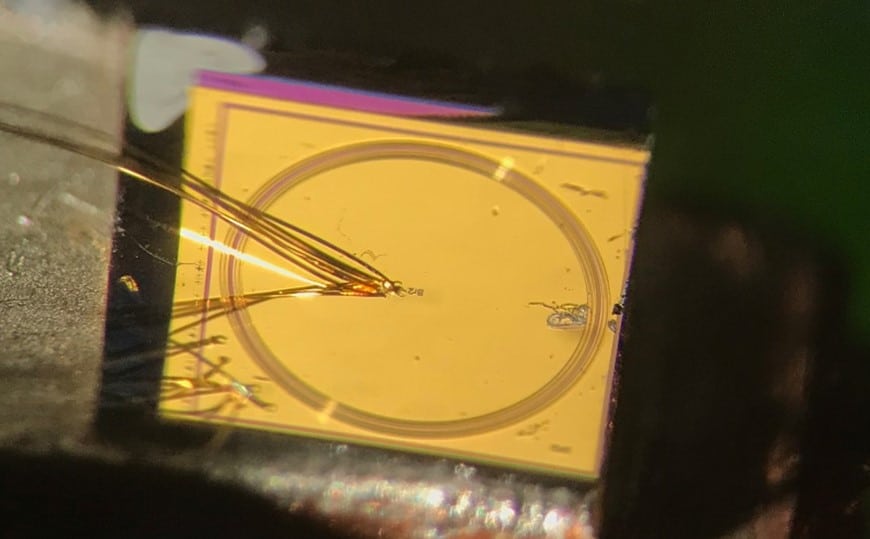
Frequency combs are one of the most important developments in metrology in the 21st century, but conventional combs are bulky and highly sensitive to external perturbations. Now two independent groups present key developments in solid state frequency combs that could lead to robust, convenient combs for use outside the laboratory. The first is an integrated, telecommunications-wavelength comb that stabilizes itself every time it is turned on. The second uses a completely new mechanism to generate frequency comb emission in the mid-infrared – a region crucial for molecular spectroscopy.
Frequency combs are pulsed lasers often described as rulers of light because they produce extremely short pulses that comprise light at regularly spaced frequencies. By fixing one of these frequencies very precisely – for example using an atomic clock – one can measure the frequency of a light signal by studying how far along the comb it falls from this reference frequency. Frequency combs have proved immensely useful in the laboratory for building better atomic clocks, improving time and frequency standards and also doing ultracold atomic and molecular spectroscopy.
The use of traditional frequency combs, however, is constrained by their need for high-power, ultrastable lasers, amplifiers and other components such as isolators to prevent feedback from destabilizing the laser. In the past decade or so, researchers have sought more user-friendly devices for applications such as fibre-optic multiplexing, time-keeping and molecular detection.
Simple components
In 2018, researchers at Columbia University in New York City led by Michal Lipson and Alexander Gaeta unveiled a solid-state, telecoms-compatible frequency comb that eliminated many specialist components. It used a low-power, electrically-pumped semiconductor laser. When a solid-state microresonator was injected with light at 1579 nm wavelength, Kerr non-linearity caused sidebands to appear at precisely spaced frequencies. The proportion of the energy in these modes gradually increased, forming a frequency comb.
Although this was a huge breakthrough, there were difficulties. A complex process was required to achieve and maintain the comb operation, and even then it did not reliably produce phase- and intensity-stable pulses called solitons. “If it’s not producing solitons, it’s not a quiet comb”, explains John Bowers of the University of California, Santa Barbara, “If you want to make an atomic clock, or a lidar, or a wavelength division multiplexing transmission system, you don’t want modulation instability. It’s not useful for most applications.”
Now, Santa Barbara researchers led by Bowers, together with scientists at Caltech and EPFL in Switzerland, unveil an integrated, solid-state laser that solves these problems. Whereas traditional frequency combs need to prevent feedback between a microresonator and the laser, this latest design utilized feedback.
Much lower noise
A cheap semiconductor laser called a distributed feedback (DFB) laser was integrated into a chip that was placed a small, precisely-controlled distance from a microresonator mounted on another chip. A physically complex non-linear interaction between the laser cavity and the microresonator created a very simple result: every time the laser was switched on, the microresonator automatically tuned itself to produce solitons. Remarkably, the resulting frequency comb had orders of magnitude lower noise than the original laser: “DFB lasers are crappy,” says Bowers, “People pay $60,000 for a laser to get linewidths that aren’t as good as this.” Moreover, the soliton state tolerated environmental disturbances such as temperature fluctuations.
The researchers hope their device could make frequency combs much more widespread: “We believe we can very soon integrate this all onto a single chip,” says Bowers. “It could be a millimetre long, it could be mass produced, it could be quite cheap, and it wouldn’t take a PhD to run. That’s what’s exciting about this.”
Turnkey system
Gaeta is impressed: “You can argue that microresonator combs have been the most active field in non-linear photonics in the past decade,” he says. “My work with Michal Lipson was the first real integrated system and these guys have made an another important step in further integrating it and making the system ‘turnkey’. It’s an important advance in taking this technology into the field.”
Meanwhile at Harvard University, Federico Capasso and colleagues focussed on creating frequency combs that operate in the mid-infrared region at 2.5-10 µm wavelength – a part of the electromagnetic spectrum in which molecules have unique spectral fingerprints. While quantum cascade lasers (QCLs) are readily available in this region, turning them into frequency combs has proven very difficult.
Surprising result
Capasso’s team investigated the possibility of producing a mid-infrared frequency comb from a quantum cascade ring laser, which behaves as its own microresonator when electrically injected. Traditional QCL frequency combs rely on bar-shaped cavities to create standing waves – something that does not happen in a symmetric ring cavity. So, the researchers added a defect to the ring to break this symmetry and allow standing waves to form. “Purely as controls, we put a few perfect rings on the chip,” explains Harvard’s Marco Piccardo. “To our surprise, these were also forming frequency combs…This is where we started scratching our heads.”
After much theoretical analysis of the laser physics, the researchers realized that the explanation lay in an instability in a non-linear differential equation called the complex Ginzburg-Landau equation, which describes spatially extended systems of coupled non-linear oscillators: “It’s not observed in bars,” says Piccardo, “The fact that a ring laser can go into this frequency comb regime is a new type of turbulent instability for quantum cascade lasers – although it’s been observed before in very different physical systems like superconductors and Bose-Einstein condensates.” The process happens in two stages: first, the single laser mode breaks up into a turbulent, unstable waveform. Eventually energy becomes concentrated in the harmonics of the original laser frequency, forming a frequency comb – albeit one with only around nine teeth.

Frequency combs power new spectrometer-on-a-chip
“There is much, much more to do,” says Piccardo. “Plenty of interesting physics was so far shown to be restricted to the world of Kerr combs. I think all this can now be shown to be possible in QCLs and on this we just made a first step. I don’t think the two systems are competitors because they are going to impact on different spectral ranges, but I think we can learn from each other.”
Both Capasso’s and Bowers’ teams have described their results in Nature.
“Both these papers have in common the problem of trying to make devices that can be hooked up to a battery to produce a broadband comb source,” says Scott Diddams, who is at the National Institute of Standards and Technology in Boulder, Colorado and was involved with either group. “The Bowers paper is much more about the nitty gritty of solving a hard problem that is going to make frequency combs prolific. The Capasso paper is an interesting, non-linear optical and general non-linear science result, but it will require additional engineering to increase the bandwidth to make it more useful for frequency comb spectroscopy.”
